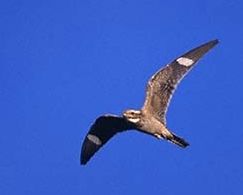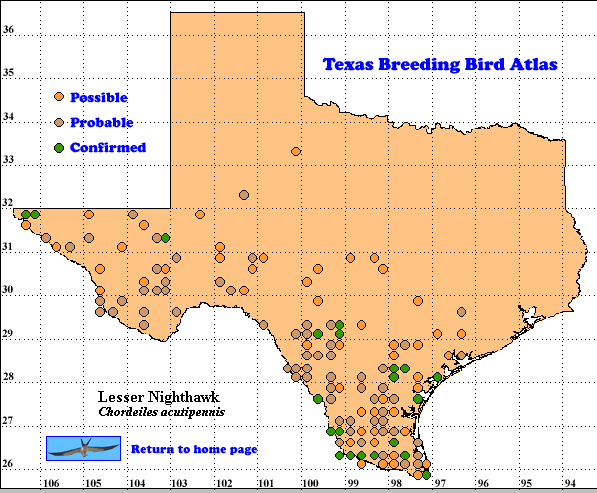The Lesser Nighthawk, previously known as the Texas Nighthawk, is a cryptically-colored bird of mottled brown, buff, and black, with distinctive white crescents on the wings and throat. Lesser Nighthawks are known for their distinctive toad-like trill (Miller 1937, Howell and Webb 1995) uttered from perches on the ground. This churring is typically heard in repeated bursts of 7-13 seconds duration and often run into series lasting 3 minutes or more, with each churr swelling quickly and fading abruptly (Howell and Webb 1995). Lesser Nighthawks are also known for their ability to tolerate both heat and cold. In the summer, nesting nighthawks use gular fluttering and other behavioral traits for temperature regulation in hot nesting environments. Although migratory, Lesser Nighthawks can also respond to cold weather and depressed food resources by remaining torpid for relatively long periods (Marshall 1955, Austin 1970). In North America the breeding distribution of this nighthawk is mostly coextensive with desert scrub habitats. Its range extends into Central and South America as well. During the day these birds rest quietly on the open ground where they blend in with the desert pavement. In the evening and early morning hours they flit gracefully and buoyantly, low over the ground or skimming the tops of bushes, as they capture aerial insects in the scoop of their open mouth. As opportunistic feeders, Lesser Nighthawks take whatever small flying insects are most abundant and most easily captured. Foraging often occurs in pairs or family groups, but solitary individuals and large flocks occur at certain times in the annual cycle.
DISTRIBUTION: Lesser Nighthawks generally nest at elevations below 2500 m (8,200 ff) from southwest United States to South America. In Texas the species nests from El Paso Co. in the west (latilong 31106) to the central Gulf coast in the east (latilong 28096), south through the Trans-Pecos, and especially the lower Rio Grande valley, and north probably as far as Big Spring (latilong 32101) and Waco (latilong 31097); it is casual further north and in the Panhandle where breeding is possible. The Lesser Nighthawk winters from Mexico to South America and is a locally uncommon winter resident in the western half of the South Texas Brush Country (Lockwood and Freeman 2004).
SEASONAL OCCURRENCE: The breeding season for the Lesser Nighthawk is long (mid-April to late-August), suggesting multiple clutches. The earliest egg date recorded by the TBBA was 27 May, but eggs have been recorded as early as 17 April (Oberholser 1974). The TBBA extended the egg-laying period to 27 August, the latest recorded date for eggs in the state. Most nests with eggs are reported in June.
BREEDING HABITAT: In Texas, the Lesser Nighthawk primarily inhabits arid lowlands, deserts, bare or somewhat brushy open country, dry gravel washes, and areas of scrub vegetation. The species is generally confined to the lowest and hottest parts of the region. It is uncommon in mountains, but has been reported up to 1220 m (4000 ft) elevation in summer in the Chisos Mountains (Wauer 1996). In North America, distribution is largely coextensive with creosote bush. Two eggs are laid on bare, flat ground, in areas often strewn with pebbles, but without any nest material. Most often nests are in full sun, but sometimes they are found in partial shade on the north side of small bushes or beneath an overhanging branch. Only females incubate eggs, and females mainly brood young. Males are the primary providers of food to the young, which are fed regurgitated insects.
STATUS: Lesser Nighthawk is reported to be locally fairly common in its breeding range in the southwestern United States including Texas (Oberholser 1974). Its status is unknown in many areas especially outside North America (Latta and Baltz 1997). Long-term (1966-2005) and shorter-term (1980-2005) population trends derived from North American Breeding Bird Survey data (Sauer et al. 2005) indicate any changes are probably small (+1%) in Texas. Where populations of Lesser Nighthawks are threatened, the reason may be habitat alteration from mining, degradation of gravel washes used for nesting, urbanization, and use of insecticides.
Text by Steven C. Latta (Posted with updates 2006).
Literature cited.
Austin, G. T. 1970. Experimental hypothermia in a Lesser Nighthawk. Auk 93: 245-262.
Howell, S. N. G. and S. Webb. 1995. A guide to the birds of Mexico and northern Central America. Oxford University Press.
Latta, S. C. and M. E. Baltz. 1997. Lesser Nighthawk (Chordeiles acutipennis) In ThebBirds of North America, No. 314 (A. Poole and F. Gill, eds.). The Birds of North America, Inc., Philadelphia, PA.
Lockwood, M. W. and B. Freeman. 2004. The TOS handbook of Texas birds. Texas A&M University Press, College Station.
Marshall, J. T., Jr. 1955. Hibernation in captive goatsuckers. Condor 57:129-134.
Miller, A. H. 1937. The nuptial flight of the Texas Nighthawk. Condor 39:42-43.
Oberholser, H. C. 1974. The bird life of Texas. University of Texas Press, Austin,
Sauer, J. R., J. E. Hines, and J. Fallon. 2005. The North American Breeding Bird Survey, results and analysis 1966-2005. Version 6.2 2006. USGS Patuxent Wildlife Research Center, Laurel MD < http://www.mbr-pwrc.usgs.gov/bbs>
Wauer, R. H. 1996. A field guide to birds of the Big Bend, 2nd ed. Gulf Publishing, Houston, TX.

